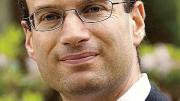“About 75 percent of our revenues are from the endowment, tuition, and sponsored research,” reports Dan Shore, Harvard’s vice president for finance and chief financial officer. “And about 75 percent of our expenses are for people and space. The growth of revenue is challenged, and the growth in expenses is tough to manage and sticky.”
Unpacking those realities provides a financial setting for The Harvard Campaign—a context Shore and Corporation member James F. Rothenberg, the University’s treasurer, began to detail in their preface to the annual financial report, published last autumn (see “Sober Finances,” January-February, page 47). They wrote about the challenges of volatile capital markets for an institution dependent on its endowment and with a “disproportionately fixed cost structure.” They pointed to University reliance on federal funding, especially for biomedical research, “when the government’s projected deficits and accumulated debt create enormous pressure to reduce such discretionary dollars.” And they noted the costs of daily and deferred campus maintenance.
“The campaign is incredibly important,” Shore said in an early-July conversation—in part because even absent new resources during the prior decade (when fundraising had to be deferred), “There are things we didn’t feel we could wait to do.” One example is financial aid. Since the undergraduate-aid initiative was liberalized in 2007 through the academic year just begun, spending on such scholarships has risen about 90 percent—an increase of nearly $90 million in the Faculty of Arts and Sciences’ (FAS) annual budget. According to FAS, in the wake of the augmented aid, greater family need during the recession, and the depreciation of its endowment, just 46 percent of current College scholarship funding is underpinned by dedicated endowments. That makes it challenging to sustain aid, and sops up much of the available unrestricted funding (from tuition and current-use gifts)—limiting FAS’s ability to invest in new priorities, or to replace lost federal research funding. University-wide, according to Shore, scholarships are a core value, but with aid only about 50 percent endowed, Harvard needs to raise a lot of money to secure them.
Similarly, FAS has begun House renewal, undertaking multimillion-dollar refurbishments of Old Quincy and Leverett’s McKinlock Hall, and proceeding with Dunster House’s roof, chimneys, and windows ahead of interior renovation—all under way this summer, using FAS funds and some recent gifts.
So the campaign must backstop these very large programs; enable Harvard to pursue what Shore called an “amazing set of opportunities”; and guard against looming problems. The importance of flexible funding has if anything risen since that 2012 financial report, simply to sustain the current research enterprise. Given the new federal budget “sequester” and continuing challenges to research grants, he said starkly, “a different social contract” between government and universities is in prospect, raising the challenge of defending “why universities are sufficiently important to justify the investment governments make in us and with us.” He described the situation as “an acute industry challenge” for higher education. Harvard’s planning, he noted, also assumes less robust capital markets and endowment returns than in recent decades. (Such concerns, raised for all of higher education by debt-rating agencies in the past year, were reinforced in an Inside Higher Ed summer survey of university chief financial officers: only small minorities expressed confidence in their schools’ financial models during the next half-decade.)
All these factors are at work at Harvard Medical School (HMS). Following a $29-million operating deficit in fiscal 2012, administrators anticipate reporting a roughly $40-million deficit in the year ended June 30. That reflects declines in sponsored-research funding generally; routine increases in salaries and costs for supplies; and investments in new programs (like the systems therapeutics initiative; see “Systematic Drug Discovery,” July-August, page 54). In response, HMS’s Next initiative has identified possible savings within the school’s administrative and operating expenses (which make up about one-quarter of its $625-million budget overall), and the school is seeking opportunities to realize new revenues from scientific discoveries.
Writ large, the same forces and responses are evident across Harvard. Even as fundraising proceeds, Shore said, it will “have to be accompanied by other things: changes that not all members of the community will find exciting” (from shared services to changes in employee benefits). In the financial realm, for example, Harvard sold its Watertown Arsenal real estate this spring, realizing $168 million, part of a continuing program to reduce debt, Shore said—and continues to examine other assets. An April debt refinancing will yield annual savings of $10 million or so during the bonds’ remaining couple of decades until maturity.
In the meantime, planning disciplines adopted since the roller-coaster circumstances of the prior decade have better equipped Harvard “to operate as a truly integrated academic institution and administrative apparatus,” Shore said, from capital planning and annual and longer-term budgeting to coordinated reporting to, and decisionmaking by, the expanded Corporation and its new financial committees. Launching new programs, he said, has become “a much more challenging question”—a productive state of affairs, he maintained, given financial constraints and the sheer costs of operating a research university. Compared to a decade ago, “We’re much better able to focus the campaign’s targets on the things that are most important to us.”
“The campaign by itself, however successful, won’t solve some of those problems,” Shore said, referring to the changed external climate. But it matters especially now, he said, because even as all universities cope with large uncertainties, “The campaign is a way we can feel emboldened” to “take our destiny in our own hands.”









